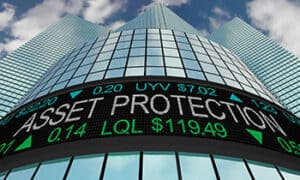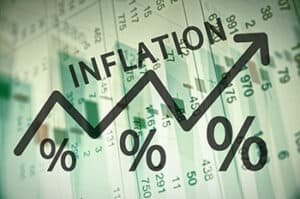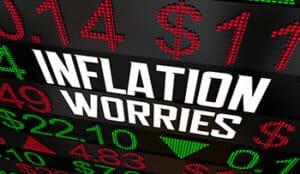
Turn on any financial news channel and before long, two so-called investment gurus will appear to debate the future direction of the economy.
Oftentimes the discussion is centered on geopolitics like Ukraine or Taiwan or whether we will have inflation or even worse, stagflation like in the 1970s when the stock market ended the decade as it began — unchanged.
Each guru will make the case with economics jargon and use data to back up their opinion but in the end… it’s just a guess.
You need more than this — you need a blueprint and ideas to adapt to the fast-changing economic and political environment.
Here are just a few recent developments:
Consumer-price inflation in America is already at a 40-year high but the surge in commodity prices over the past month, in the wake of Russia’s invasion of Ukraine, gives rise to a key question: is the global economy now seeing a 1970s-style price shock on top of a supply chain crunch?
And what about the rising US-Russia-China rivalry leading to conflict beyond Ukraine deeper into Europe or erupting in Asia such as Taiwan or the South China Sea?
Despite these uncertainties and risks, many investors will continue to put their portfolios on automatic pilot without any hedging or rebalancing.
This would be a mistake since where prices go will have an impact on your pocketbook and your stock portfolio. You need to protect both. There is a compelling reason for gold, commodities and other strategies to protect your portfolio.
More on this in a moment… but first let’s first look deeper at the inflation issue.

My college textbook defines inflation as “a persistent increase in the level of consumer prices or a persistent decline in the purchasing power of money, caused by an increase in available currency and credit beyond the proportion of available goods and services.”
Inflation is an upward movement in the average level of prices. Its opposite is deflation, a downward movement in the average level of prices.[2]
Inflation is the expansion of money and credit. Deflation is the contraction of money and credit. The boundary between inflation and deflation is price stability and the most common situation is a low level of inflation in the 1% to 3% range.
There you have it. The jaws of high inflation can squeeze your purchasing power and nest egg while the claws of deflation pull both an economy’s growth rate and stock markets down to earth.
As an aside, while many economists believe that the Federal Reserve has the tools to control inflation today by raising interest rates, we need to face the fact that the amount of America’s debt will make fighting inflation harder than in the past.
Why? Federal debt held by the public is now more than 100% of GDP, and a large share of that debt is short term (30% has a maturity of a year and over 60% a maturity of four years). Therefore, any ramp up of interest rates sufficient to fight inflation would quickly lead to a large increase in interest payments for all of us.
What is driving huge federal budget deficits and monster growth in America’s national debt? George Mason University’s Mercatus Center has confirmed that it is spending growth in three budgetary areas: 47% from Medicare, 22% from Medicaid and the 2010 Affordable Care Act (ACA), and 15% from Social Security.
Now let’s turn to the issue of just what is too much inflation.

In a healthy economy, there will always be a modest inflation since it serves as a lubricant to the wheels of commerce and keeps economic momentum moving forward.
Price stability leads to all actors in an economy being able to make sound economic decisions and fosters a virtuous cycle of growth and progress.
But very high inflation discourages investment and savings, i.e., the fuel for growth and productivity.
Let’s just look at the probabilities of each occurring, how they will affect your financial health and, most importantly, what you can do to hedge your bets and protect your investment portfolio.
It is important to note that price levels reflect, to a large degree, psychological leanings. For example, if most people expect prices to rise sharply, producers will raise prices to protect themselves, workers will negotiate higher pay increases and the cycle continues and accelerates.
The same is true with deflation. If consumers believe that overall prices will fall, they will delay large purchases, companies will reduce costs to maintain margins, and economic growth will suffer.
I’ll soon offer you some investment ideas and strategies to cope with either scenario but let’s see how inflation can affect your money and result in a scenario even worse than high inflation.

Before getting into your investments, let’s briefly look at how rising and falling price levels impact your pocketbook and your investment portfolio.
Normally, rising inflation is coupled with a rising cost of money better known as interest rates. These higher interest rates and the decline in your real spending power are like a one-two punch to your standard of living.
The 2021 US economy closed on an absolute tear… with the unemployment rate at the end of 2021 at just 3.9%.[3]
The Fed right now is attempting to slow down this incredible growth in 2022 to combat inflation. This is due to some obvious reasons including the ongoing global supply chain issues and a tight labor market.
The ongoing war between Russia & Ukraine is adding extra supply chain stress to the delivery of vital items across the globe such as oil & gas, wheat, metals. and especially fertilizer.
“The markets are now adjusting to the next worsening of the crisis,” said Paul Horsnell, head of commodities research at Standard Chartered Plc. “Things that were unthinkable a week ago are not unthinkable now.”[4]
During high inflationary periods, the American economy is not as productive since borrowing, capital spending and productivity all decline. In an economy where inflation is rising quickly, interest rates rarely keep up, causing savers' hard-earned dollars to lose some buying power.
Retirees are especially hard hit since a high inflation rate often means wage increases, but that won't benefit those who are retired.
Homeowners with variable mortgage rates and people with credit card balances see their borrowing costs climb periodically along with the broader inflation in the economy, leading to larger payments. Many people are not prepared for higher interest rates and the potential reduction in cash flows to come.
The real estate and construction business is particularly hard hit since high inflation leads to sharply rising home prices, high interest rates for mortgages and a relentless slide in the value of any money people have put away for a down payments.
Stagflation is the awful combination of lack of growth (stagnation) and persistent, substantial increase in prices (inflation). Remember the 1970s? Or are you either too young or still trying to forget?
In the 1970s (during the Nixon, Ford, and Carter administrations), the Fed would stumble between stimulating the economy, trying to head off a recession — and then restraining the economy, trying to keep inflation from spinning out of control.
In the end, Nixon tried to spend his way out of it and expanded entitlements (not an option now) before Carter & Volcker finally crushed inflation by sharply increasing interest rates to cause a recession — thereby wringing inflationary expectations out of the economy like a wet rag.
Provided that you get in early, a great place to be during a deflationary environment is in long-term bonds.
Avoid most financial companies, especially mortgage-oriented lenders that see collateral coverage plummet as housing prices fall and borrowers drop a notch or two in credit quality. Cash is king and stocks get killed during deflationary times though there can be periodic and powerful rallies such as those that occurred during the 1930s.
The strongest case for a coming period of high inflation is not the Fed pumping enormous amounts of liquidity into our economy, but rather that inflation is perhaps the only way out of America’s incredible debt problem.
We now face $+1 trillion annual budget deficits as far as the eye can see. And high inflation is the government’s best strategy to reduce the impact of high debt.
Michael Lewis writes in The Atlantic how in 1979, for example, the government ran a deficit of more than $40 billion — equivalent to about $118 billion in today’s money.
The national debt stood at about $830 billion as of 1980.
Now, the US national debt held by the public is over $23 trillion ($700,000 for each American) with $1–$2 trillion budget deficits forecast for the next five years.
In short, this is why you should be concerned about inflation and ultimately your investments.

What should be your investment strategy if you expect inflation not just to go up a notch but get entirely out of control?
Just the word "inflation" strikes fear into the hearts of many Americans worried about a stagnating economy, rising prices, a falling dollar and an income that many people just can't keep up with the cost of living.
But while a high inflation rate hurts many Americans financially, it also presents opportunities for smart investors.
Stock market investors get some protection from inflation because the same factors that raise the price of goods also raise the values of companies. But coping with the fear of high inflation is not easy because of uncertainty — the goal posts and the rules both keep moving.
While some companies can react to inflation by raising their prices, others who compete within a global market may find it difficult to stay competitive with foreign producers who don’t have to raise prices due to inflation. More importantly, inflation robs investors by raising prices with no corresponding increase in value.
Adding some gold and commodities to your portfolio and nest egg is a great way to hedge this risk and protect your purchasing power.[4]

Inflation and the US Dollar
There is also a high probability that higher inflation will lead to a decline in the value of the US Dollar.
This would impact your purchasing power and raise the real cost of everything America imports. This ranges from food to apparel to electronics and in short, a weaker dollar means a decline in our overall standard of living.
Increasing global uncertainty and risk
Investors may wish to avoid it but there are a rising number of risks and unexpected shocks known as “black swans” that could turn your portfolio and finances upside down.[5]
Here are just a few of them:
For all these reasons, gold is an excellent hedge on uncertainty and where investors worldwide go for some stability and safety.
Now let’s get to the many ways to invest in gold.
Gold coins and gold bullion are perhaps the most obvious hard asset to own. This strategy avoids mining and market risk and is also both liquid and fully tradable.
The SPDR Gold Shares (NYSE: GLD) exchange-traded fund is also a good play on the price of gold and seeks to replicate the performance of the price of gold bullion on a one-to-ten ratio. The shares trade on the NYSE and may be bought and sold like any other securities.
If you feel more venturesome, the Market Vectors Junior Gold Miners ETF (NYSE: GDXJ) offers a more indirect exposure to gold through ownership in a portfolio of small and medium sized gold miner equities that generate at least 50% of their revenues from gold and/or silver mining. Keep in mind that these smaller mining companies can be volatile.
You could also invest directly into a few high-quality gold stocks.
Barrick Gold (NYSE: GOLD) has recently merged with Randgold Resources and is working with Newmont Corporation (NYSE: NEM) in Nevada through a joint venture. Barrick Gold earlier made a takeover bid for Newmont so these two giants will both compete and cooperate on a grand scale.
Finally, if you wish for a broader play on real assets that includes gold, take a look at the below ideas.
Energy Exploration & Resources
The energy sector is perhaps the best inflation-resistant sector of the stock market, and for good reason. Inflation itself often reflects rising energy prices, which in turn have knock-on effects on other goods and services, since the price of all economic activities has energy as an input cost.
EOG Resources (NYSE: EOG) is a Houston-based oil and gas explorer and producer, and prices of both commodities have jumped in 2022.
EOG has been a top performer this year as a strong balance sheet and a 2.7% dividend makes EOG a solid pick.
Energy Select Sector SPDR Fund (NYSE: XLE) was recently selected by Alexander Green in the April issue of The Oxford Communiqué. There, he points out that "the world will require a substantial carbon-based energy sector for decades to come," even as we move toward a greener future.
Food, Chemicals, Metals
Sociedad Química y Minera de Chile S.A. (NYSE: SQM) of Chile, one of the world’s largest lithium produces, is benefiting from the lithium battery-based electric vehicle (EV) boom. But SQM also produces crop inputs such as potash and potassium nitrate, with the company’s now important fertilizer business comprising 33% of total gross profits.
SQM is better positioned than most pure-play fertilizer companies since it is diversified. But with fertilizer prices surging and supplies for the three main crop nutrients expected to be harder to obtain in the coming months due to Russian sanctions, this stock could continue its trajectory uptrend.[6]
Nitrogen fertilizer is made through a combination of natural gas and air, while phosphate and potash are typically mined from the earth.
The Mosaic Company (NYSE: MOS) is a producer of key inputs for the agricultural market like potash and phosphate. This Florida-based company essentially is in the chemical commodity business. It's been a great business thus far in 2022, with markets rewarding shareholders to the tune of 12% returns while the broader stock market has been down.
The stock is still a good value priced at less than 10 times earnings. In addition, potash fertilizer prices are soaring largely because a key component, natural gas, is also becoming more expensive in the inflationary environment and the fallout from the Ukraine situation.
The Van Eck Market Vectors Hard Assets ETF (NYSE: HAP), which weights each sector based on its share of world consumption, includes energy at 41%, agriculture at 31%, base metals at 13%, precious metals at 7%, forest products at 4%, and alternative energy at 4%. A whopping 87% of the companies in this basket are large cap.
I hope this discussion of inflation and deflation, debt, currency, and geopolitical competition has been helpful and should underscore any level of uncertainty in today’s capital markets.
One thing should be clear — no one knows precisely how future events will unfold and leaning against the winds of conventional wisdom is oftentimes a smart strategy.
Now is the time to consider adding some gold, commodities and other real assets to your investment strategy since it serves as an effective hedge and shock absorber in times of uncertainty.

Carl Delfeld, Contributor
for Investors News Service
P.S. To discover more opportunities in the hottest sectors in North America, sign up now to the Financial News Now newsletter to get the latest updates and investment ideas directly in your inbox!
DISCLAIMER: Investing in any securities is highly speculative. Please be sure to always do your own due diligence before making any investment decisions. Read our full disclaimer here.
[1] https://www.bls.gov/opub/ted/2022/consumer-prices-for-food-up-7-9-percent-for-year-ended-february-2022.htm#:~:text=The%20Consumer%20Price%20Index%20rose,month%20advance%20since%20July%201981
[2] Inflation & Deflation, Their Causes and Effects by Kimberly Amadeo, The Balance, November 9, 2018, https://www.thebalance.com/us-economic-outlook-3305669
[3] Guide to Investing in Gold & Silver, by Michael Maloney
[4] https://www.bnnbloomberg.ca/commodities-hit-new-highs-as-traders-shun-russian-purchases-1.1731569
[5] The Black Swan: The Impact of the Highly Improbable by Nassim Nicholas Taleb
[6] The Economist - The inflationary consequences of Russia’s war will spread, https://www.economist.com/finance-and-economics/the-inflationary-consequences-of-russias-war-will-spread/21808192
POLICY SPOTLIGHT: Why Federal Deficits Are Skyrocketing and How to Fix Them, Mercatus Center, March 25, 2022, https://www.mercatus.org/publications/federal-fiscal-policy/policy-spotlight-why-federal-deficits-are-skyrocketing-and-how
U.S. Bureau of Labor Statistics, https://www.bls.gov/opub/ted/2022/consumer-prices-for-food-up-7-9-percent-for-year-ended-february-2022.htm#:~:text=The%20Consumer%20Price%20Index%20rose,month%20advance%20since%20July%201981.